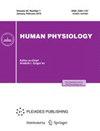掩模对水平面运动信号定位的影响
Q4 Medicine
引用次数: 0
摘要
摘要研究了在自由场条件下掩蔽器对运动信号定位的影响。实验是在消声室中进行的。声音信号来自位于水平面半圆弧上的扬声器。带通噪声爆发(5 - 18khz)用于创建信号和掩模。信号和掩模是不相关的刺激,是由两个独立的噪声爆发产生的。静止掩模始终以15°的角度在右侧。移动信号沿两个位置(-86°到-52°和-52°到-18°)的两条路径到达或离开掩蔽器。信号和持续时间为1-s的掩蔽器要么同时出现,要么相对于掩蔽器的出现有信号出现的延迟。延迟从1到40毫秒和1200毫秒不等。受试者评估移动声音轨迹的起点和终点。将屏蔽条件下移动信号的定位数据与隔离(无屏蔽)时相同信号的空间估计进行比较。比较了掩蔽条件下信号起始点和结束点的定位与单独运动源的定位。结果表明,掩蔽器影响信号轨迹的起始点和终点。这种变化取决于运动的方向。起始点总是沿着信号的运动方向移动。终点向相反方向移动。本文章由计算机程序翻译,如有差异,请以英文原文为准。
The Influence of the Masker on the Localization of the Moving Signal in the Horizontal Plane
Abstract The effect of the masker on the localization of the moving signal was investigated in the free field conditions. The experiments were carried out in an anechoic chamber. Sound signals were presented from loudspeakers located on a semicircular arc in the horizontal plane. Bandpass noise bursts (5–18 kHz) were used to create a signal and a masker. The signal and the mask were uncorrelated stimuli and were created from two independent noise bursts. The stationary masker was always on the right at an angle of 15°. The moving signals traveled to or from the masker along two paths located at two places (–86° to –52° and –52° to –18°). The signal and the masker of 1-s duration each were presented either simultaneously or with a delay of the signal onset relative to the masker onset. The delay varied from 1 to 40 ms and 1200 ms. The subjects evaluated the start and end points of the trajectory of the moving sounds. Localization data for a moving signal under masking conditions were compared with spatial estimates of the same signal when presented in isolation (without a masker). Localization of the start and end points of the signal in masking condition was compared with localization of the moving source alone. Results showed that the masker affected the start and end points of the signal trajectory. The shift depended on the direction of movement. The starting points were always shifted in the direction of motion of the signal. The end points were shifted in the opposite direction.
求助全文
通过发布文献求助,成功后即可免费获取论文全文。
去求助
来源期刊

Human Physiology
Medicine-Physiology (medical)
CiteScore
0.70
自引率
0.00%
发文量
69
期刊介绍:
Human Physiology is an international peer reviewed journal aimed at promoting the integration of theory, methods, and research in human physiology. The journal publishes original studies on brain function and its disturbances, including neural mechanisms subserving perception, learning, memory, emotion, and language. Human Physiology provides a forum for many areas of physiology, such as respiration, circulation, the blood system, motor functions, and digestion, as well as sport and occupational physiology. All kinds of papers on environmental physiology, including adaptation to extreme (polar zone, desert) and new (space) external conditions, are encouraged. Each year, the journal has thematic issues. The journal is highly interested in the cooperation of scientists from all countries and accepts manuscripts submitted in English or Russian.
 求助内容:
求助内容: 应助结果提醒方式:
应助结果提醒方式:


